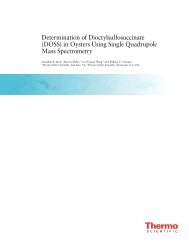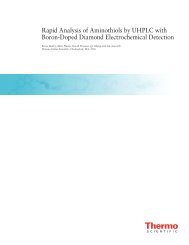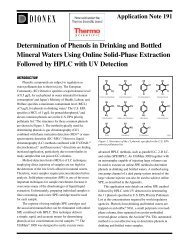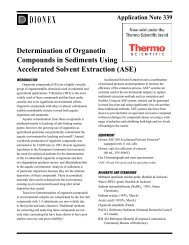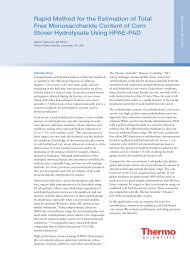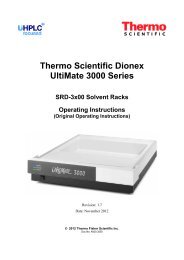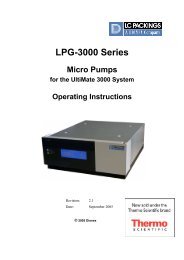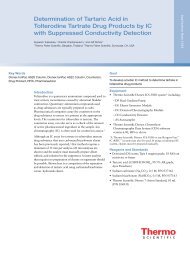Determination of Galactosamine Containing Organic ... - Dionex
Determination of Galactosamine Containing Organic ... - Dionex
Determination of Galactosamine Containing Organic ... - Dionex
You also want an ePaper? Increase the reach of your titles
YUMPU automatically turns print PDFs into web optimized ePapers that Google loves.
Application Note 233<br />
<strong>Determination</strong> <strong>of</strong> <strong>Galactosamine</strong> <strong>Containing</strong><br />
<strong>Organic</strong> Impurities in Heparin by HPAE-PAD<br />
Using the CarboPac PA20 Column<br />
INTRODUCTION<br />
In early 2008, unusual reactions to heparin, including<br />
hypotension, swelling <strong>of</strong> the larynx, and in some cases<br />
death, prompted a recall <strong>of</strong> the product. 1,2 The lots <strong>of</strong><br />
heparin that led to these anaphylactic reactions were<br />
tested using existing reported methods and no additional<br />
components were found. After extensive investigation,<br />
it was determined that the heparin in question had been<br />
contaminated with oversulfated chondroitin sulfate. 3<br />
At the time <strong>of</strong> the recall, existing heparin assay<br />
methods could not detect chondroitin sulfates in heparin.<br />
For this reason, the U.S. Pharmacopeia (USP) has<br />
proposed a revision to the heparin sodium monograph that<br />
includes chromatographic methods for the identification<br />
<strong>of</strong> heparin and the determination <strong>of</strong> organic impurities in<br />
heparin. 4 This USP monograph is scheduled to become<br />
<strong>of</strong>ficial on August 15, 2009. The heparin chromatographic<br />
identity portion <strong>of</strong> the monograph, which determines<br />
oversulfated chondroitin and dermatan sulfate in heparin,<br />
will not be discussed in this Application Note (AN), but is<br />
available elsewhere. 5<br />
The organic impurities section <strong>of</strong> the heparin<br />
monograph relies on hydrolyzing the polysaccharide and<br />
determining the relative amounts <strong>of</strong> galactosamine and<br />
glucosamine in the sample digests. Heparin is composed<br />
<strong>of</strong> glucosamine and uronic acid. Acid hydrolysis <strong>of</strong><br />
heparin samples releases glucosamine, which is easily<br />
determined by electrochemical detection. In comparison,<br />
chondroitin sulfates are composed <strong>of</strong> galactosamine and<br />
uronic acid. In these compounds, acid hydrolysis releases<br />
galactosamine, which can also easily be determined by<br />
electrochemical detection. The USP method measures<br />
the ratio <strong>of</strong> galactosamine/glucosamine as an indication<br />
<strong>of</strong> the heparin purity and to identify heparin samples that<br />
may be contaminated or adulterated with chondroitin<br />
sulfate compounds.<br />
In this AN, the organic impurities in heparin<br />
are determined by the HPAE-PAD method using the<br />
CarboPac ® PA20 column following the USP monograph<br />
method. This method was repeated using manually<br />
prepared eluents and an electrolytically generated eluent,<br />
with both eluent preparation options providing data<br />
that exceeds the system suitability requirements in the<br />
monograph. In addition, this document includes deliberate<br />
variation <strong>of</strong> several chromatographic parameters to<br />
evaluate method ruggedness. The HPAE-PAD method<br />
provides sensitive determination <strong>of</strong> galactosamine in<br />
acid- hydrolyzed heparin samples, enabling the<br />
identification <strong>of</strong> heparin that has been contaminated<br />
with chondroitin sulfates.
EQUIPMENT<br />
<strong>Dionex</strong> ICS-3000 Reagent-Free IC system with eluent<br />
generation (RFIC-EG ) system consisting <strong>of</strong>:<br />
SP Single Pump or DP Dual Pump module<br />
(Gradient pump required if manual eluent is used)<br />
EG Eluent Generator module<br />
DC Detector/Chromatography module (single or dual<br />
temperature zone configuration)<br />
AS Autosampler<br />
EluGen ® EGC II KOH cartridge (<strong>Dionex</strong> P/N 058900 )<br />
Continuously-Regenerated Anion Trap Column,<br />
CR-ATC (<strong>Dionex</strong> P/N 060477)<br />
ICS-3000 ED Electrochemical detector<br />
(<strong>Dionex</strong> P/N 061719)<br />
Electrochemical cell (<strong>Dionex</strong> P/N 061757)<br />
Disposable gold electrode, carbohydrate certified<br />
(<strong>Dionex</strong> P/N 060139)<br />
Reference electrode (<strong>Dionex</strong> P/N 061879)<br />
10 µL PEEK Sample injection loop (<strong>Dionex</strong> P/N 042949)<br />
EG Vacuum Degas Conversion Kit (<strong>Dionex</strong> P/N 063353)<br />
Chromeleon ® 6.8 Chromatography Data System<br />
0.3 mL polypropylene injection vials with caps<br />
(<strong>Dionex</strong> P/N 055428)<br />
Nalgene ® 1000 mL 0.2 µm nylon filter units<br />
(VWR P/N 28198-514)<br />
7 mL polypropylene screw cap tubes<br />
(Sarstedt P/N 60.550)<br />
500 mL PMP volumetric flasks, Class A<br />
(Vitlab P/N 67504)<br />
Dry block heater (VWR P/N 13259-005)<br />
REAGENTS AND STANDARDS<br />
Deionized water (DI), Type I reagent grade, 18 MΩ-cm<br />
resistivity or better<br />
Hydrochloric acid, Ultrex II, (JT Baker P/N 6900-05)<br />
Potassium hydroxide, 45% (w/w) (Fisher P/N SP236-500)<br />
Sodium hydroxide, 50% (w/w) (Fisher P/N SS254-500)<br />
Glucosamine hydrochloride (Sigma-Aldrich P/N G-4875)<br />
<strong>Galactosamine</strong> hydrochloride (Pfanstiehl Laboratories<br />
P/N RGG-104)<br />
2 <strong>Determination</strong> <strong>of</strong> <strong>Galactosamine</strong> <strong>Containing</strong> <strong>Organic</strong> Impurities in Heparin<br />
by HPAE-PAD Using the CarboPac PA20 Column<br />
SAMPLES<br />
Chondroitin sulfate B, sodium salt (β-heparin, dermatan<br />
sulfate, sodium salt) (Sigma-Aldrich P/N C3788)<br />
Sample A: Heparin, sodium salt, grade 1-A<br />
(Sigma-Aldrich P/N H3393)<br />
Sample B: Heparin, sodium salt (Sigma-Aldrich<br />
P/N H4784)<br />
CONDITIONS<br />
Columns: AminoTrap column<br />
3 × 30 mm (P/N 060146)<br />
CarboPac PA20 Analytical,<br />
3 × 150 mm (P/N 060142)<br />
-or-<br />
AminoTrap column,<br />
3 × 30 mm (P/N 060146)<br />
CarboPac PA20 Guard,<br />
3 × 30 mm (P/N 060144)<br />
CarboPac PA20 Analytical, 3 × 150 mm<br />
(P/N 060142) (manual eluent only)<br />
Eluent: 14 mM KOH from -10–0 min,<br />
14 mM KOH from 0–10 min,<br />
100 mM KOH from 10–20 min<br />
Eluent Source: EGC II KOH with CR-ATC<br />
Flow Rate: 0.5 mL/min<br />
Temperature: 30 °C<br />
Inj. Volume: 10 µL<br />
-or-<br />
200 mM KOH, manually prepared<br />
Detection: Pulsed amperometric,<br />
disposable gold working electrode<br />
Background: 5–25 nC (using the carbohydrate<br />
waveform)<br />
Noise: 20–50 pC<br />
System<br />
Backpressure: ~2625 psi (using the<br />
AminoTrap 3 × 30 mm and<br />
CarboPac PA20 3 × 150 mm columns)<br />
-or-<br />
~3010 psi (using the AminoTrap<br />
3 × 30 mm, CarboPac PA20 3 × 30 mm<br />
guard, and CarboPac PA20 3 × 150 mm<br />
analytical columns as described<br />
by the USP)
Carbohydrate 4-Potential Waveform for the ED<br />
Time(s) Potential(V) Gain Region* Ramp* Integration<br />
0.00 +0.1 Off On Off<br />
0.20 +0.1 On On On<br />
0.40 +0.1 Off On Off<br />
0.41 –2.0 Off On Off<br />
0.42 –2.0 Off On Off<br />
0.43 +0.6 Off On Off<br />
0.44 –0.1 Off On Off<br />
0.50 –0.1 Off On Off<br />
*Settings required in the ICS-3000, but not used in older<br />
<strong>Dionex</strong> systems.<br />
Reference electrode in Ag mode (Ag/AgCl reference).<br />
See Technical Note 21 for more information. 6<br />
PREPARATION OF SOLUTIONS AND REAGENTS<br />
Eluent Solutions<br />
Generate the potassium hydroxide (KOH) eluent<br />
online by pumping high-quality degassed, DI water<br />
through the EGC II KOH cartridge. The Chromeleon<br />
s<strong>of</strong>tware will track the amount <strong>of</strong> KOH used and calculate<br />
the remaining lifetime.<br />
The method can be executed with manually prepared<br />
eluents. Prepare 1 L <strong>of</strong> 200 mM KOH from 45% w/w<br />
KOH concentrate by adding 17 mL <strong>of</strong> 45% KOH to<br />
983 g <strong>of</strong> degassed, DI water. If desired, NaOH can be<br />
used in place <strong>of</strong> KOH. To prepare 1 L <strong>of</strong> 200 mM NaOH,<br />
add 10.4 mL <strong>of</strong> 50% NaOH to 989.6 mL <strong>of</strong> degassed,<br />
DI water.<br />
Proportion the 200 mM hydroxide solution with DI<br />
water to produce either a 14 mM NaOH or KOH eluent<br />
for the sample elution or a 100 mM NaOH or KOH<br />
eluent for column cleaning. See Tech Note 71 for detailed<br />
information on manual eluent preparation. 7<br />
5 N Hydrochloric Acid for Sample Digestion<br />
Dilute 102 g (88 mL) <strong>of</strong> 33% hydrochloric acid to a<br />
total <strong>of</strong> 211 g with DI water.<br />
Standard Stock Solutions<br />
Glucosamine<br />
Prepare a 1.6 mg/mL stock solution <strong>of</strong> glucosamine<br />
hydrochloride by dissolving 0.1600 g <strong>of</strong> glucosamine<br />
hydrochloride in 100 mL <strong>of</strong> 5 N hydrochloric acid.<br />
This stock will be used to prepare the standard solution<br />
for digestions.<br />
<strong>Galactosamine</strong><br />
Prepare a 16 mg/mL solution <strong>of</strong> galactosamine<br />
hydrochloride by dissolving 0.0320 g <strong>of</strong> galactosamine<br />
hydrochloride in 2.00 mL <strong>of</strong> DI water. Further dilute<br />
this concentrate by adding 100 µL to 99.9 mL <strong>of</strong> 5 N<br />
hydrochloric acid to prepare a 16 µg/mL stock solution<br />
<strong>of</strong> galactosamine.<br />
Glucosamine and galactosamine stock solutions were<br />
stored at 4 °C.<br />
Standard Solution<br />
Prepare the standard solution by transferring 2.5 mL<br />
<strong>of</strong> glucosamine stock solution into a 7 mL screw cap<br />
vial containing 2.5 mL <strong>of</strong> galactosamine stock solution.<br />
This solution contains 8 µg/mL <strong>of</strong> galactosamine and<br />
800 µg/mL <strong>of</strong> glucosamine (1% w/w galactosamine with<br />
respect to glucosamine). Freshly prepare the standard<br />
solution before each digestion.<br />
DIGESTION OF SAMPLES<br />
Prepare samples for digestion by adding 12 mg <strong>of</strong><br />
heparin to a 7 mL screw cap vial. Add 5 mL <strong>of</strong> 5 N HCl to<br />
the vial and vortex the solution to mix. Heat the samples<br />
and the standard solution at 100 °C for 6 h to hydrolyze<br />
the samples into glucosamine and galactosamine. After<br />
digestion <strong>of</strong> the samples, allow the samples to cool to<br />
ambient temperature, quantitatively transfer the contents<br />
<strong>of</strong> the vial to a 500 mL PMP volumetric flask, and fill to<br />
the mark on the flask with DI water.<br />
Application Note 233 3
PRECAUTIONS AND ExPERIMENTAL CONSIDERATIONS<br />
Labware<br />
Glass volumetric flasks should not be used for<br />
dilution <strong>of</strong> samples and standards after digestion.<br />
Peak heights may be reduced if glass is used. For this<br />
application, Class A PMP flasks were used, although<br />
polypropylene would be acceptable. Similarly,<br />
polypropylene, rather than glass, digestion vials and<br />
injection vials should be used.<br />
When using PMP or polypropylene labware, it is<br />
important to remove bubbles from the surface <strong>of</strong> the<br />
plastic labware. This can be accomplished by gently<br />
swirling the solution in the volumetric flask while it is<br />
approximately one-half full. The final dilution should be<br />
made by gently adding water down the side <strong>of</strong> the flask.<br />
Bubbles on the walls <strong>of</strong> the flask can lead to dilution<br />
errors. Similarly, bubbles in injection vials should be<br />
tapped out before the samples are loaded in the AS to<br />
ensure consistent injection volumes.<br />
Use <strong>of</strong> Sodium Hydroxide for Manual Eluent Preparation<br />
Sodium hydroxide can be substituted for potassium<br />
hydroxide when manually preparing eluents. Glucosamine<br />
peak asymmetry and resolution between galactosamine<br />
and glucosamine pass the USP requirements.<br />
Equilibration <strong>of</strong> the Column and Retention Time Precision<br />
To optimize retention time precision, each sequence<br />
should start with 3–5 injections <strong>of</strong> a 50 mM HCl blank.<br />
When using EG, equilibration <strong>of</strong> the system with three<br />
blank acid injections led to retention time precision RSDs<br />
ranging from
190<br />
nC<br />
Column: AminoTrap, 3 × 30 mm, CarboPac PA20 3 × 150 mm<br />
Eluent: 14 mM KOH from -10–0 min, 14 mM KOH from 0–10 min,<br />
100 mM KOH from 10–20 min (using EG)<br />
Temperature: 30 °C<br />
Flow Rate: 0.5 mL/min<br />
Inj. Volume: 10 µL<br />
Detection: PAD, Au (Disposable)<br />
Sample Prep.: Acid hydrolysis<br />
Samples: <strong>Galactosamine</strong>/glucosamine standard solution<br />
Peaks: 1. <strong>Galactosamine</strong> 80 ng/mL<br />
2. Glucosamine 8000<br />
10<br />
0 2.5 5.0 7.5 10<br />
Minutes<br />
26128<br />
Figure 1. Separation <strong>of</strong> the standard solution on the<br />
CarboPac PA20.<br />
Sample Analysis<br />
Calculations: The percentage <strong>of</strong> GalN in the heparin<br />
digests is calculated by comparison against the standard<br />
solution, which contains 1% (w/w) <strong>of</strong> GalN/GlcN in<br />
5 N HCl. For each set <strong>of</strong> digestions a 5 mL aliquot <strong>of</strong><br />
standard solution was also digested and the relative<br />
response <strong>of</strong> GalN/GlcN was calculated by the<br />
following formula:<br />
Response ratio:<br />
(GalN R ) = (GalN B )/(GalN W ) * (GlcN W )/(GlcN B )<br />
Where:<br />
GalN B = the galactosamine peak area from the<br />
hydrolyzed standard solution<br />
GalN W = the weight <strong>of</strong> galactosamine in the<br />
standard solution<br />
GlcN W = the weight <strong>of</strong> glucosamine in the standard<br />
solution<br />
GlcN B = the glucosamine peak area from the<br />
hydrolyzed standard solution<br />
1<br />
2<br />
150<br />
nC<br />
Column: AminoTrap, 3 × 30 mm, CarboPac PA20 3 × 150 mm<br />
Eluent: 14 mM KOH from -10–0 min, 14 mM KOH from 0–10 min,<br />
100 mM KOH from 10–20 min (using EG)<br />
Temperature: 30 °C<br />
Flow Rate: 0.5 mL/min<br />
Inj. Volume: 10 µL<br />
Detection: PAD, Au (disposable)<br />
Sample Prep.: Acid hydrolysis<br />
Samples: Heparin sample A spiked with 1% dermatan sulfate (day 1)<br />
Peaks: 1. <strong>Galactosamine</strong> 1.29 %<br />
2. Glucosamine 98.7<br />
10<br />
0 2.5 5.0<br />
Minutes<br />
7.5 10<br />
26129<br />
Figure 2. Separation <strong>of</strong> acid-hydrolyzed heparin spiked with<br />
1% dermatan sulfate on the CarboPac PA20.<br />
The response ratio <strong>of</strong> GalN/GlcN determined for the<br />
standard solutions ranged from 1.03 to 1.19 during four<br />
weeks <strong>of</strong> sample analysis.<br />
The response factor was used to calculate the<br />
percentage <strong>of</strong> galactosamine in the heparin digests<br />
according to the formula below:<br />
% GalN = [GalN U /GalN R ] /<br />
[(GalN U /GalN R ) + GlcN U ] × 100<br />
Where:<br />
GalN U = the galactosamine peak area from the<br />
hydrolyzed heparin sample<br />
GalN R = the response ratio<br />
GlcN U = the glucosamine peak area from the<br />
hydrolyzed heparin sample<br />
Figure 2 shows the separation <strong>of</strong> heparin sample A<br />
spiked with 1% (w/w) <strong>of</strong> dermatan sulfate (chondroitin<br />
sulfate B). The GalN peak is well resolved from GlcN<br />
(USP resolution = 3.2) and 1.29% GalN was determined<br />
in the sample. In unspiked samples, 0.04% galactosamine<br />
was determined in the hydrolysate.<br />
1<br />
2<br />
Application Note 233 5
Day Sample<br />
1<br />
2<br />
3<br />
Table 1. Comparison <strong>of</strong> Triplicate Heparin Analysis Results to USP Criteria When Using an EG Eluent*<br />
% GalN<br />
(USP limit<br />
Instrumental<br />
Conditions<br />
Manually prepared KOH<br />
proportioned to 14 mM<br />
CarboPac PA20<br />
Column 1<br />
Manually prepared KOH<br />
proportioned to 14 mM<br />
Column 2<br />
Manually prepared NaOH<br />
proportioned to 14 mM<br />
Column 2<br />
Table 2: Comparison <strong>of</strong> Triplicate Heparin Analysis Results to USP Criteria<br />
When Using Manually Prepared KOH or NaOH Eluents*<br />
% GalN<br />
Sample<br />
(USP limit<br />
REFERENCES<br />
1. Contaminant Detected in Heparin Material <strong>of</strong><br />
Specified Origin in the USA and in Germany; Serious<br />
Adverse Events Reported; Recall Measures Initiated.<br />
World Health Organization Alert No. 118, March 7,<br />
2008. http://www.who.int/medicines/publications/<br />
drugalerts/Alert_118_Heparin.pdf. Last accessed<br />
05/04/09.<br />
2. Recall <strong>of</strong> Heparin Sodium Injection and Heparin<br />
Lock Flush Solution (Baxter) FDA Public Health<br />
Update, February 2, 2008. http://www.fda.gov/cder/<br />
drug/infopage/heparin/public_health_update.htm.<br />
Last accessed 05/18/09.<br />
3. Guerrini, M.; Beccati, D.; Shriver, Z.; Naggi, A.;<br />
Viswanathan, K.; Bisio, A.; Capila, I.; Lansing,<br />
J.C.; Guglieri, S.; Fraser, B.; Al-Hakim, A.; Gunay,<br />
N.S.; Zhang, Z.; Robinson, L.; Buhse, L.; Nasr,<br />
M.; Woodcock, J.; Langer, R.; Venkataraman, G.;<br />
Linhardt, R.J.; Casu, B.; Torri, G.; Sasisekharan, R.;<br />
Oversulfated Chondroitin Sulfate is a Contaminant<br />
in Heparin Associated with Adverse Clinical Events,<br />
Nature Biotechnology 2008, 26, 669–675.<br />
Passion. Power. Productivity.<br />
<strong>Dionex</strong> Corporation<br />
1228 Titan Way<br />
P.O. Box 3603<br />
Sunnyvale, CA<br />
94088-3603<br />
(408) 737-0700<br />
North America<br />
U.S./Canada (847) 295-7500<br />
South America<br />
Brazil (55) 11 3731 5140<br />
Europe<br />
Austria (43) 1 616 51 25 Benelux (31) 20 683 9768 (32) 3 353 4294<br />
Denmark (45) 36 36 90 90 France (33) 1 39 30 01 10 Germany (49) 6126 991 0<br />
Ireland (353) 1 644 0064 Italy (39) 02 51 62 1267 Sweden (46) 8 473 3380<br />
Switzerland (41) 62 205 9966 United Kingdom (44) 1276 691722<br />
4. Heparin Sodium, Pharmocopeial Forum<br />
2009, 35, 1–10.<br />
5. <strong>Dionex</strong> Corporation. <strong>Determination</strong> <strong>of</strong> Oversulfated<br />
Chondroitin Sulfate, Dermatan Sulfate, and Heparin<br />
Sodium Using Anion-Exchange Chromatography with<br />
UV Detection (IC-UV), Application Note 235, LPN<br />
2306. Sunnyvale, CA, 2009.<br />
6. <strong>Dionex</strong> Corporation. Optimal Settings for Pulsed<br />
Amperometric Detection <strong>of</strong> Carbohydrates Using the<br />
<strong>Dionex</strong> ED40 Electrochemical Detector, Technical<br />
Note 21, LPN 034889-03. Sunnyvale, CA, 1998.<br />
7. <strong>Dionex</strong> Corporation. Eluent Preparation for High-<br />
Performance Anion-Exchange Chromatography with<br />
Pulsed Amperometric Detection, Technical Note 71,<br />
LPN 1932-01. Sunnyvale, CA, 2007.<br />
CarboPac, EluGen, and Chromeleon are registered trademarks and AminoTrap,<br />
Reagent-Free, and RFIC-EG are trademarks <strong>of</strong> <strong>Dionex</strong> Corporation.<br />
Nalgene is a registered trademark <strong>of</strong> Nalge Nunc International.<br />
PEEK is a registered trademark <strong>of</strong> Victrex PLC.<br />
Asia Pacific<br />
Australia (61) 2 9420 5233 China (852) 2428 3282 India (91) 22 2764 2735<br />
Japan (81) 6 6885 1213 Korea (82) 2 2653 2580 Singapore (65) 6289 1190<br />
Taiwan (886) 2 8751 6655<br />
LPN 2286 PDF 06/09<br />
©2009 <strong>Dionex</strong> Corporation<br />
www.dionex.com




